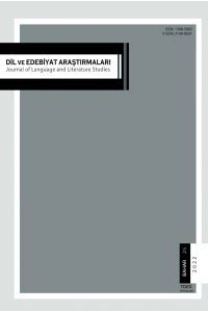Exploring the Efficacy of Video Project Assignments in English Language Learning through the Lens of Tertiary-Level EFL Students
Exploring the Efficacy of Video Project Assignments in English Language Learning through the Lens of Tertiary-Level EFL Students
EFL, Student-generated video-project assignment, Video-based assignment, Video-making Video-project assignment (VPA),
___
- Aksel, A., & Gürman-Kahraman, F. (2014). Video project assignments and their effectiveness on foreign language learning. Procedia-Social and Behavioral Sciences, 141, 319–324. https://doi.org/10.1016/j.sbspro.2014.05.055
- Arsenis, P., Flores, M., & Petropoulou, D. (2022). Enhancing graduate employability skills and student engagement through group video assessment. Assessment & Evaluation in Higher Education, 47(2), 245-258. https://doi.org/10.1080/02602938.2021.1897086
- Boey, C.K., Sathish, S., & Koh, S.N.A. (2023). Impact of technology-enabled project-based assessments on learner outcomes in higher education. International Journal of
- Mobile Learning and Organisation, 17(1-2), 131-148. https://doi.org/10.1504/IJMLO.2023.128354
- Dahya, N. (2017). Critical perspectives on youth digital media production: ‘Voice’ and representation in educational contexts. Learning, Media and Technology, 42(1), 100–111. https://doi.org/10.1080/17439884.2016.1141785 de Koff, J.P. (2021). Utilizing teaching technologies for higher education in a post-COVID-19 environment. Natural Sciences Education, 50(1), 1-12. https://doi.org/10.1002/nse2.20032
- Dressman, M. (2019). Multimodality and language learning. In M. Dressman, & R. W. Sadler (Eds.), The handbook of informal language learning (pp. 39-55). John Wiley & Sons Ltd. https://doi.org/10.1002/9781119472384.ch3
- Fraenkel, J. R., & Wallen, N. E. (1993). How to design and evaluate research in education (2nd ed.). McGraw Hill.
- Hayes, A. F. (2018). Introduction to mediation, moderation, and conditional process analysis: A regression-based approach (Methodology in the social sciences) (2nd ed.). The Guilford Press.
- Jorm, C., Roberts, C., Gordon, C., Nisbet, G., & Roper, L. (2019). Time for university educators to embrace student videography. Cambridge Journal of Education 49(6), 673–693. https://doi:10.1080/0305764X.2019.1590528
- Meyer, E., & Forester, L. (2015). Implementing student-produced video projects in language courses: Guidelines and lessons learned. Die Unterrichtspraxis/Teaching German, 48(2), 192–210. https://doi.org/10.1111/tger.10195
- Miller, L., Hafner, C. A., & Fun, C. N. K. (2012). Project-based learning in a technologically enhanced learning environment for second language learners: Students’ perceptions. E-Learning and Digital Media, 9(2), 183–195. https://doi.org/10.2304/elea.2012.9.2.183
- Mohamed, K. A., Mohd Zaid, N., Ibrahim, N. H., Abdullah, A. H., Surif, J., & Hussin, A. J. (2021). The use of video project assignment (VPA) to enhance students’ achievement in communicative English subject. International Journal of Emerging Technologies in Learning (iJET), 16(23), 29–42. https://doi.org/10.3991/ijet.v16i23.27447
- Namin, A., Ketron, S. C., Kaltcheva, V. D., & Winsor, R. D. (2021). Improving student presentation skills using asynchronous video-based projects. Journal of Management Education, 45(6), 987–1010. https://doi.org/10.1177/1052562920978805
- Nanni, A. & Pusey, K. (2020). Leveraging students’ digital literacy through project-based learning. The Asian EFL Journal, 24(1), 141-164.
- Park, H. & Hiver, P. (2017). Profiling and tracing motivational change in project-based L2 learning. System, 67, 50-64. https://doi.org/10.1016/j.system.2017.04.013
- Parker, J. L. (2020). Students’ attitudes toward project-based learning in an intermediate Spanish course. International Journal of Curriculum and Instruction, 12(1), 80-97.
- Perez, C. (2010). Technological revolutions and techno-economic paradigms. Cambridge Journal of Economics, 34(1), 185–202. http://www.jstor.org/stable/24232030
- Petersen, C. & Nassaji, H. (2016). Project-based learning through the eyes of teachers and students in adult ESL classrooms. Canadian Modern Language Review, 72(1), 13-39. http://dx.doi.org/10.3138/cmlr.2096
- Shih, W.-L. & Tsai, C.-Y. (2017). Students’ perception of a flipped classroom approach to facilitating online project-based learning in marketing research courses. Australasian Journal of Educational Technology, 33(5), 32-49. https://doi.org/10.14742/ajet.2884
- Shin, M.-H. (2018). Effects of project-based learning on students’ motivation and self-efficacy. English Teaching, 73(1), 95–114. https://doi.org/10.15858/engtea.73.1.201803.95
- Simpson, J. (2011). Integrating project-based learning in an English language tourism classroom in a Thai University [Doctoral dissertation, Australian Catholic University]. https://doi.org/10.4226/66/5a961e4ec686b
- Souzandehfar, M., Saadat, M., & Sahragard, R. (2014). The significance of multimodality/multiliteracies in Iranian EFL learners’ meaning-making process. Iranian Journal of Applied Linguistics, 17(2), 115–143.
- Taylor, S. A., Hunter, G. L., Melton, H., & Goodwin, S. A. (2011). Student engagement and marketing classes. Journal of Marketing Education, 33(1), 73-92. https://doi.org/10.1177/0273475310392542
- Ting, N. C. (2013). Classroom video project: An investigation on students’ perception. Procedia-Social and Behavioral Sciences, 90, 441–448. https://doi.org/10.1016/j.sbspro.2013.07.113
- Yeh, H.-C., Heng, L., & Tseng, S-S. (2021). Exploring the impact of video making on students’ writing skills. Journal of Research on Technology in Education, 53(4), 446-456. https://doi.org/10.1080/15391523.2020.1795955
- Zacharis, N. Z. (2010). Innovative assessment for learning enhancement: Issues and practices. Contemporary Issues in Education Research, 3(1), 61-70.
- ISSN: 1308-5069
- Yayın Aralığı: 2
- Başlangıç: 2010
- Yayıncı: TÜRKİYE DİL VE EDEBİYAT DERNEĞİ
İç Benliği Ararken: Yunus Emre’nin Mistisizmi ve Emerson’ın Aşkıncılığı
Hücvirî, Ali b. Osman Cüllâbî, Keşfu’l-mahcûb (Hakikat Bilgisi), Haz.
Old Age and Greed in Ṣāʾib Tabrīzī’s Ghazals
Servet-i Fünûn Şairi Cenab Şahabeddin’in Geliştirdiği Mizah Felsefesi
Sezai Karakoç’ta Okuma Kültürü ve Okuma Biçimleri
Klasik Türk Şiiri’nde Vahdet-i Vücûd Felsefesi
Yunus Emre’nin Meşhur ve Meçhul Bir Şiiri Üzerine Bazı Mülahazalar
